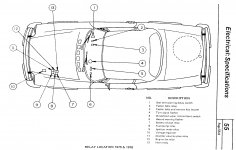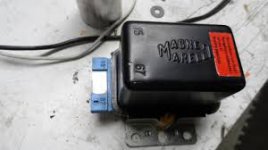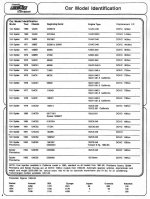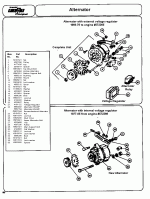1976 Spider 124: The alternator is outputting 15 volts, but it is not charging the battery (brand new). When car is started, it will continue to run with the battery disconnected. Battery is not charging when connected. Since the alternator is outputting 15 volts, is there a voltage regulator? If so, where is it located? Is there a source for a wiring schematic?
You are using an out of date browser. It may not display this or other websites correctly.
You should upgrade or use an alternative browser.
You should upgrade or use an alternative browser.
Technical Battery Charging Issues
- Thread starter fiat76
- Start date
Currently reading:
Technical Battery Charging Issues
Editing this because I was wrong Davren is correct.
Humble apologies.
the voltage at the battery with engine running should be around 13.5 volts up to 14.8 volts is fine.
Disconnecting an alternator with the engine running is likely to destroy the voltage regulator.
If you want have your new battery checked sometimes even new batteries are duff.
How do you know battery not charging?
Humble apologies.
the voltage at the battery with engine running should be around 13.5 volts up to 14.8 volts is fine.
Disconnecting an alternator with the engine running is likely to destroy the voltage regulator.
If you want have your new battery checked sometimes even new batteries are duff.
How do you know battery not charging?
Last edited:
1976 Spider 124: The alternator is outputting 15 volts, but it is not charging the battery (brand new). When car is started, it will continue to run with the battery disconnected. Battery is not charging when connected. Since the alternator is outputting 15 volts, is there a voltage regulator? If so, where is it located? Is there a source for a wiring schematic?
Hi, Welcome to the FF.
1975 and 1976 models have an external voltage regulator (item 10 on the diagram below). If it's not there, the charging system may have been modified to an internally regulated alternator.
1975 and 1976 models also have a charge indicator light relay (item 7). Internally regulated alternators don't need that relay.
EDIT: For some reason, I can't upload the diagram. The external voltage regulator is in front of the relays mounted on the left front inner wing. It should have 2 terminals on it, labelled 67 and 15.
.
Last edited:
Thanks, Davren, for your quick reply. When I get back to the garage, I will check things out again!
1975 and 1976 models have an external voltage regulator (item 10 on the diagram below). If it's not there, the charging system may have been modified to an internally regulated alternator.
***** I am pretty sure there is not an external voltage regulator, but I will check again! The alternator appears to be new, so perhaps it was modified at some point in time.
1975 and 1975 [do you mean 1976?] models also have a charge indicator light relay (item 7). Internally regulated alternators don't need that relay.
EDIT: For some reason, I can't upload the diagram. The external voltage regulator is in front of the relays mounted on the left front inner wing. It should have 2 terminals on it, labelled 67 and 15.
*****Is there a link to the diagram you could send to me?
1975 and 1976 models have an external voltage regulator (item 10 on the diagram below). If it's not there, the charging system may have been modified to an internally regulated alternator.
***** I am pretty sure there is not an external voltage regulator, but I will check again! The alternator appears to be new, so perhaps it was modified at some point in time.
1975 and 1975 [do you mean 1976?] models also have a charge indicator light relay (item 7). Internally regulated alternators don't need that relay.
EDIT: For some reason, I can't upload the diagram. The external voltage regulator is in front of the relays mounted on the left front inner wing. It should have 2 terminals on it, labelled 67 and 15.
*****Is there a link to the diagram you could send to me?
1975 and 1975 [do you mean 1976?]
Yes... typo. Corrected it now.
Is there a link to the diagram you could send to me?
No.... it's just a scan from the Spider workshop manual. I'll upload it here when the forum administrator has fixed the problem.
.
*****Is there a link to the diagram you could send to me?
Upload problem fixed. Here's the diagram.
.
Attachments
Many thanks!Upload problem fixed. Here's the diagram.
.
I use a meter on the battery to determine it's not charging.Editing this because I was wrong Davren is correct.
Humble apologies.
the voltage at the battery with engine running should be around 13.5 volts up to 14.8 volts is fine.
Disconnecting an alternator with the engine running is likely to destroy the voltage regulator.
If you want have your new battery checked sometimes even new batteries are duff.
How do you know battery not charging?
Are you measuring the voltage at the battery terminals with the engine running?I use a meter on the battery to determine it's not charging.
If yes what is the voltage you are reading?
Yes, I am measuring the battery terminals with the engine running and I get a reading of 12.4. I use a clamp on meter to measure the current from the alternator to the battery and I get no reading. There is no current flowing into the battery.Are you measuring the voltage at the battery terminals with the engine running?
If yes what is the voltage you are reading?
When we measure output at the alternator, it's 15 volts (14.9) with the battery connected. When we disconnect the battery, the engine continues to run (means the alternator is supplying the energy for the spark...lights work.....it's just not charging the battery. I have to determine if there is a separate voltage regulator and if there is, where is it located. IF the alternator that had been put in has a built in regulator, must I bypass the original voltage regulator. Work was previously done years ago, and car is not run frequently.
Ah it looks very much that there is a problem in the main wire from the alternator (where you measured 15v) and the battery where you measured 12.4v.
If the wire is good the voltage at the two points must be the same.
Do not run the car with battery disconnected.
If the wire is good the voltage at the two points must be the same.
Do not run the car with battery disconnected.
I use a clamp on meter to measure the current from the alternator to the battery and I get no reading. There is no current flowing into the battery.
Are you using a DC only or AC + DC amp clamp? The much cheaper AC only clamps won't measure DC.
Are you clamping it around only one of the main battery cables? Clamping it around both cables will cancel out any reading.
When we disconnect the battery, the engine continues to run
As suggested above, it's not a good idea to run the alternator with the battery disconnected. It can cause serious damage to the alternator diodes.
I have to determine if there is a separate voltage regulator and if there is, where is it located.
It's a large black or grey box fitted under the bonnet (hood) similar to the picture below. If it's there, you can't miss it.
IF the alternator that had been put in has a built in regulator, must I bypass the original voltage regulator.
If it's been modified to the later internally regulated alternator, the external regulator would have been removed. You should be able to see wiring modifications where the external regulator was mounted.
Are you sure it's a 1976 car, and not a later one? Several members on here have been confused as to which year there Spiders are. The identification pages below should confirm which you have.
You may also get some clues from the diagram of the two different alternators for the up to, and post 1976 models from the parts catalogue.
.
Attachments
Will investigate Jackwhoo's suggestion there could be a problem with the wire from the alternator to the battery. We will not run the engine with the battery disconnected.Are you using a DC only or AC + DC amp clamp? The much cheaper AC only clamps won't measure DC.
Are you clamping it around only one of the main battery cables? Clamping it around both cables will cancel out any reading.
As suggested above, it's not a good idea to run the alternator with the battery disconnected. It can cause serious damage to the alternator diodes.
It's a large black or grey box fitted under the bonnet (hood) similar to the picture below. If it's there, you can't miss it.
If it's been modified to the later internally regulated alternator, the external regulator would have been removed. You should be able to see wiring modifications where the external regulator was mounted.
Are you sure it's a 1976 car, and not a later one? Several members on here have been confused as to which year there Spiders are. The identification pages below should confirm which you have.
You may also get some clues from the diagram of the two different alternators for the up to, and post 1976 models from the parts catalogue.
.
I should have mentioned from the get-go that I have a background in electrical engineering.
I am using a clamp that measures both AC and DC. I am only clamping around one battery cable. I should have mentioned I have a background in electrical engineering to save you and Jackwhoo some time explaining. You have given me some good leads as to determining if there is, indeed, a voltage regulator, where to look for it, determine if there is a wire issue, etc. I will keep you posted as to what I find out. Yes, I am certain it's a 1976 Fiat. I have the original bill of sale and the manual (with a few chunks out of the cover thanks to a hungry mama mouse).Are you using a DC only or AC + DC amp clamp? The much cheaper AC only clamps won't measure DC.
Are you clamping it around only one of the main battery cables? Clamping it around both cables will cancel out any reading.
As suggested above, it's not a good idea to run the alternator with the battery disconnected. It can cause serious damage to the alternator diodes.
It's a large black or grey box fitted under the bonnet (hood) similar to the picture below. If it's there, you can't miss it.
If it's been modified to the later internally regulated alternator, the external regulator would have been removed. You should be able to see wiring modifications where the external regulator was mounted.
Are you sure it's a 1976 car, and not a later one? Several members on here have been confused as to which year there Spiders are. The identification pages below should confirm which you have.
You may also get some clues from the diagram of the two different alternators for the up to, and post 1976 models from the parts catalogue.
.
You can just run a wire of the correct gauge from the alternator output connector to the battery +veWill investigate Jackwhoo's suggestion there could be a problem with the wire from the alternator to the battery. We will not run the engine with the battery disconnected.
I should have mentioned from the get-go that I have a background in electrical engineering.
On some old British cars the out put wires were a pair in order to keep the gauge small enough to be easily manipulated in the wiring loom. Depending on your alternator connector you may choose to do the same.
Even if you had mentioned your back ground ,similar questions may have been asked. Not to talk down to you or annoy you . in my opinion best to avoid assuming what has been done and how.
If you find a voltage regulator on the front wing car still may have had later alternator fitted , separate voltage regulator may have been disabled but left in place to look original.
If your alternator has a number of round holes all over rear face it is a marelli with external regulator.
If rear of alternator has a big red part then its marelli with internal regulator.
If alternator has elongated holes at edge of rear face then it's Bosch with internal regulator.
If rear of alternator has a big red part then its marelli with internal regulator.
If alternator has elongated holes at edge of rear face then it's Bosch with internal regulator.
Last edited:
Thanks, Jackwhoo! Oh, no...NOT annoyed at all. You are right, best to cover all the bases and never assume! The advice we have received has been a great help, and we appreciate the timely support. We (I am at the computer end and he is on the car end) will keep you posted on the outcome. Now we have some "direction"!You can just run a wire of the correct gauge from the alternator output connector to the battery +ve
On some old British cars the out put wires were a pair in order to keep the gauge small enough to be easily manipulated in the wiring loom. Depending on your alternator connector you may choose to do the same.
Even if you had mentioned your back ground ,similar questions may have been asked. Not to talk down to you or annoy you . in my opinion best to avoid assuming what has been done and how.
If you find a voltage regulator on the front wing car still may have had later alternator fitted , separate voltage regulator may have been disabled but left in place to look original.
Similar threads
- Replies
- 0
- Views
- 927






